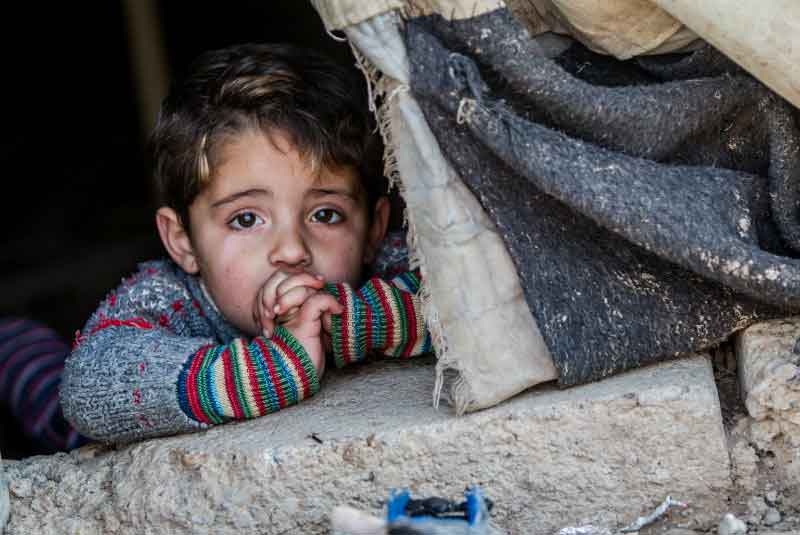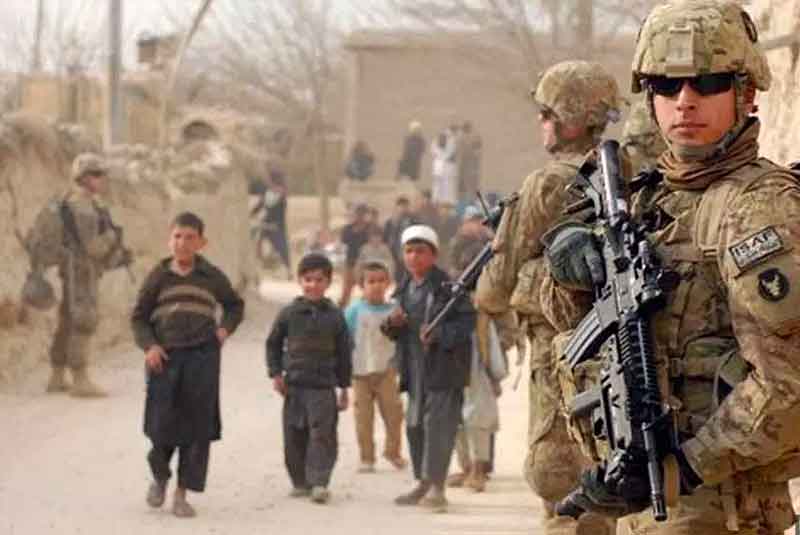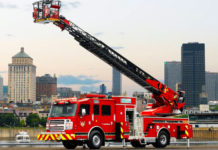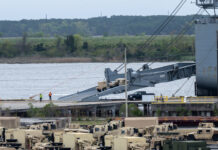
By Kim Hjelmgaard, USA TODAY
President Trump announced Friday evening that he ordered precision missile strikes against the regime of Syrian dictator Bashar Assad in a coordinated attack with the United Kingdom and French allies.
A U.S. strike will be designed to punish Assad, but it probably won’t alter the balance of power in Syria, where a civil war has entered its eighth year and shows no sign of ending.
The conflict that began as a peaceful uprising against Assad’s regime escalated into a full-scale civil war that is now one of this century’s deadliest.
(Learn More. The airstrikes, targeting and destroying three chemical weapons facilities, were ordered in response to another suspected chemical attack in Syria. Courtesy of ABC News and YouTube. Posted on Apr 14, 2018)
Along the way, the Syrian conflict allowed Islamic State extremists to flourish, created the world’s worst refugee crisis since World War II and exacerbated an international power struggle.
After seven years of relentless bloodshed, here is a recap of the crisis:
Why did the civil war start?
Economic problems and a lack of freedom caused resentment toward Assad’s authoritarian rule.
His forces responded to protesters in 2011 by killing hundreds of them and imprisoning many more as other pro-democracy uprisings known as the Arab Spring were taking place across the Middle East.

As public anger intensified, the growing chaos attracted extremist fighters throughout the region, including remnants of al-Qaeda in Iraq and an offshoot that became the Islamic State, or ISIS. Eventually, a full Syrian rebellion was mounted against Assad’s regime.
Some of these rebel groups started fighting each other as well as Assad’s military forces because of sectarian divisions, complicating the situation.
How many have been killed?
According to the U.N., 400,000 Syrians have been killed and more than half of the country’s 20 million, pre-war population has been displaced.
About 5.5 million Syrians have fled abroad — 95% of them in just five countries (Turkey, Lebanon, Jordan, Iraq and Egypt), according to humanitarian groups.
(US Ambassador to the United Nations Nikki Haley said the United States was prepared to sustain its pressure on Syria after a night of military strikes meant to cripple the country’s ability to use chemical weapons, as Russia accused Washington of “hooliganism” and a major breach of international law. Courtesy of CNN and YouTube. Posted on Apr 14, 2018)
What about other humanitarian costs?
Assad’s latest offensive is aimed at securing the region around the capital Damascus. The gas attack was in a region just outside the city.
Thousands of civilians remained trapped in opposition-held suburbs of Syria’s capital Damascus as Assad’s government wages a relentless bombing campaign to retake the area.
How has the war impacted the country’s infrastructure?
About a third of Syria’s housing and half of its educational and medical facilities have been destroyed, according to a 2017 World Bank report.

Of Syria’s estimated 10 million children, 8.6 million are in dire need of assistance, up from about a half-million after the first year of war.
Nearly 6 million children are displaced or living as refugees, and about 2.5 million are out of school.
What is the U.S. involvement in Syria?
The United States has about 2,000 troops on the ground in Syria, based mostly in northeast Syria.
Their mission is straightforward: to support local militias fighting the Islamic State. The troops are serving as advisers and providing other support, including air power.
(Retired Army Major General James “Spider” Marks explains to CNN’s Anderson Cooper the challenges US troops face with Russian forces in Syria. Courtesy of CNN and YouTube. Posted on Apr 13, 2018)
The U.S. troops are not in conflict with Assad’s armed forces or their Iranian and Russian backers.
The U.S. is backing diplomatic efforts to end the conflict but is attempting to fight the Islamic State without taking sides in the civil war.
What are the risks of a U.S. strike?
The biggest risk is an attack on Assad’s forces that ends up drawing world powers into a global conflict.
A year ago the Trump administration authorized a strike on Assad’s regime in retaliation for a similar nerve agent attack.
The U.S. strike was calibrated so that it would punish the Assad regime without collapsing Assad’s government or drawing Russia and Iran into the conflict.

The Trump administration may be contemplating a more severe strike this time, but it will need to do so carefully to avoid unintended consequences.
Why is Russia involved?
The conflict has turned into a proxy war.
The United States started arming and providing military air cover in 2014 for anti-Assad rebel groups who were also waging war against ISIS.
Washington also began working with Syrian Kurds, one of the strongest partners in the fight against ISIS. After that support appeared to turn the tide against Assad, Russia — a longtime Syrian ally — entered the conflict in 2015 to shore up Assad’s struggling regime.
In addition, Russian President Vladimir Putin wanted to assert his country’s power on the world stage.
(Russia’s ambassador to UN condemns airstrikes on Syria. Courtesy of Daily Mail and YouTube. Posted on Apr 14, 2018)
What support is Iran providing?
Iran provided much-needed ground troops for the Assad regime, funneling money and fighters through the Lebanon-based Hezbollah militant group to further establish a strong presence in the region.
Israel has been indirectly involved as it fears Iran could use Syrian territory to stage attacks on Israel or transfer weapons to Hezbollah.
Iran is Israel’s arch-enemy and has sworn to destroy the country.
What is Turkey’s interest in the conflict?
Turkey, Syria’s northern neighbor, extended its ground operations into Syria, fearing the conflict could embolden Turkey’s large population of Kurds to demand independence.
In recent days, Turkish troops surrounded the Kurdish-held city of Afrin, forcing hundreds of civilians to flee.
What happens next?
Over the years, there have been various peace talks and United Nations resolutions calling for cease-fires to allow aid to reach areas where civilians were trapped.
The cease-fires did not last or were violated. And most of the peace talks have stumbled on a major sticking point: the fate of Assad.

Mara Karlin, an intelligence and security expert at the Brookings Institution think tank, wrote in a February blog post, that “the fundamental debate for Washington going forward must focus on whether counterterrorism or broader geopolitical affairs should be the priority in Syria.”
She noted that her congressional testimony in 2012 about Syria is still relevant.
The Syrian conflict “will not end with Bashar Assad voluntarily stepping aside, or choosing exile.
It will not end with him making sufficient reforms to enable a transparent and free Syrian state. Let me be clear: continued oppression and violence in Syria will continue,” she wrote in 2012.
Contributing: Alan Gomez
Original post https://www.usatoday.com/story/news/world/2018/04/09/syria-conflict-explained-bashar-assad/498756002/
(Defense Secretary James Mattis and Gen. Joseph Dunford, Chairman of the Joint Chiefs of Staff, say airstrikes launched Friday evening were designed to inflict “maximum damage” to Syrian chemical weapons facilities. Courtesy of CBS News and YouTube. Posted on Apr 13, 2018)
Pentagon: U.S. Allied Strike Set Back Syrian Chemical Weapons Program ‘For Years’
By Doug Stanglin, Gregory Korte, and Tom Vanden, USA TODAY
In a largely uncontested attack, U.S., British and French forces unleashed 105 missiles on three Syrian chemical weapons facilities early Saturday, leveling at least one building and setting back the country’s chemical weapons program “for years,” Pentagon officials said.
The strikes targeted three areas of Syria: a scientific research center near Damascus, a chemical weapons storage facility west of Homs and a storage facility and command post near Homs.
Lt. Gen. Kenneth McKenzie, director of the Joint Staff at the Pentagon, told reporters Saturday that the weapons used in the operation were a mix of sea and air-launched missiles fired by U.S., British and French forces and “successfully hit every target.”
(During the Pentagon press briefing, Lt. Gen. Kenneth McKenzie, the director of the Joint Staff, said that the airstrikes accomplished their mission in Syria, setting back the chemical weapons program in Syria by years. Courtesy of CNN and YouTube. Posted on Apr 14, 2018)
The goal, he said, was to hit the “very heart” of Syria’s chemical weapons program by targeting its research, development and storage facilities.
The strikes come one week after reports of a grisly chemical attack in the town of Douma that killed more than 40 people.
“This is going to set the Syrian chemical weapons program back for years,” McKenzie said.

Syrian forces fired 40 surface-to-air missiles during the operation, mostly after the attack was over, he said.
“They were largely ineffective and increased risk to their own people,” he said. “None of our aircraft or missiles involved in this operation were successfully engaged by Syrian air defenses.”
He also said there was no indication that Russian air-defense systems were employed during the attacks.
McKenzie said there were no initial reports of civilian casualties in large part because the operation was planned to be carried out during the night. “We weren’t trying to kill a lot of people,” he said.
President Trump, in a Saturday morning tweet, called the nighttime attack a “perfectly executed strike.”
“Mission Accomplished!” he added.
Gen. Joseph Dunford, the chairman of the Joint Chiefs of Staff, said late Friday that that the operation was “a one-time shot” but did not rule out further attacks.
While the Pentagon stressed the narrow, precise nature of the attacks, Trump emphasized in announcing the strikes that the allied forces “are prepared to sustain this response until the Syrian regime stops its use of prohibited chemical agents.”
Syria has denied using chemical weapons. But Friday night, the White House released what it said was “a significant body of information” that pointed to the use of chlorine gas — and possibly also the deadly nerve agent sarin.
That evidence includes victim statements, images of barrel bomb fragments and reliable reports of Syrian government helicopters in the area.
(U.S. examines evidence in suspected chemical attack in Syria. Courtesy of CBS News and YouTube. Posted on Apr 12, 2018)
A former officer in Syria’s chemical program, Adulsalam Abdulrazek, said Saturday that the joint U.S., British, and French strikes hit “parts of but not the heart” of the program.
He said the strikes were unlikely to curb the government’s ability to produce or launch new attacks.
Speaking from rebel-held northern Syria, Abdulrazek told the Associated Press there were perhaps 50 warehouses in Syria that stored chemical weapons before the program was dismantled in 2013.
In addition, France issued a “national assessment” on the chemical attack based on intelligence reports, information from non-governmental sources, such as relief teams, on the scene and a close examination of information and video from social media.
The report said France considers it “beyond possible doubt” that a chemical attack was carried out in Douma on April 7 and “there is no plausible scenario other than that of an attack by Syrian armed forces as part of a wider offensive” in the area.

It added that Russia has “undeniably” provided active military support for Damascus and “provided constant political cover to the Syrian regime over the employment of chemical weapons.”
At an emergency meeting Saturday of the U.N. Security Council, Russian ambassador Vassily Nebenzia said Russian experts on the ground in Douma found no evidence of a chemical attack. He said the alleged attack had been “staged” by foreign intelligence services.
He demanded a vote by the 15-member Security Council on a resolution condemning the “aggression” against Syria by the U.S., Britain and France, but the measure was voted down.
Only three countries — Russia, China and Bolivia — voted in favor of the resolution. Eight countries voted against and three abstained. A resolution needs at least 9 “yes” votes to be approved.
U.N. Secretary-general Antonio Gutteres condemned the use of chemical weapons but sought to reduce tension.
“I urge all member states to show restraint in these dangerous circumstances and to avoid any acts that could escalate matters and worsen the suffering of the Syrian people,” he said.
A perfectly executed strike last night. Thank you to France and the United Kingdom for their wisdom and the power of their fine Military. Could not have had a better result. Mission Accomplished!
— Donald J. Trump (@realDonaldTrump) April 14, 2018
Nikki Haley, U.S. ambassador to the U.N., said “the time for talk ended last night” with the allied attack on Syrian chemical weapons sites.
“The pictures of dead children were not fake news, they were the result of the Syrian regime’s barbaric inhumanity,” she said.
The U.S. envoy said the U.S. had tried numerous efforts to get Syria to give up its chemical weapons program and had no option but to act militarily.
“When our president draws a red line, our president enforces the red line,” Haley said.
“We are prepared to sustain this pressure if the Syrian regime is foolish enough to test our will,” she said, warning that in the event of another chemical attack by Syria, the U.S. is “locked and loaded.”
(Learn More. The UN Security Council has held an emergency session to discuss the suspected gas attack on a rebel-held town in Syria. The attack is believed to have killed more than 70 people, including children. Courtesy of BBC News and YouTube. Posted on Apr 5, 2018)
While Russia and Syria sharply condemned the U.S., British and French attack, their initial response was verbal not military.
Russia’s U.S. embassy released a statement warning that the airstrikes will “not be left without consequences.” It said that “all responsibility” rests with Washington, London and Paris.
In a sign that Russia is unlikely to escalate tensions, however, Russian Deputy Foreign Minister Sergei Ryabkov said Saturday that Moscow is in touch with the three countries that carried out the strike.
“We need to cooperate,” Ryabkov told the Russian newspaper Kommersant.
An international inspection team from the Organization for the Prohibition of Chemical Weapons planned to enter the city Saturday to investigate last week’s chemical weapons attack.
Syria’s President Bashar Assad announced that his country would respond to the allied attack but offered no details.
(Learn More. The Syrian president sat down for a 2011 interview with ABC’s Barbara Walters to discuss how he treats protesters in his country. Courtesy of ABC News and YouTube. Posted on Apr 14, 2018)
In Damascus immediately after the attack, hundreds of residents — many waving Syrian, Russian and Iranian flags — rushed to the landmark Omayyad square of the Syrian capital.
Some clapped their hands and danced, other drove in convoys, honking their horns in defiance.
“We are your men, Bashar,” they shouted, according to the Associated Press.
“This military intervention is very important after what happened,” said Abu Thaa’r, an unemployed 32-year-old from Idleb in a phone interview.
“Either these (chemical) weapons are internationally prohibited or not. The airstrikes should have happened earlier.”
He was optimistic that American might and U.S. allies would help his country.
“The bombings will change the situation in Syria, especially in terms of limiting the role of Russia,” Thaa’r said. “The bombing maybe will also help in getting rid of the Assad regime and find a solution for the crisis by having new order that we the Syrian people want.”
(Learn More. The US, UK and France have bombed multiple government targets in Syria in an early morning operation targeting alleged chemical weapons sites. Courtesy of BBC News and YouTube. Posted on Apr 14, 2018)
Leen Hamdan, 20, a university student, lives in Bazreh, the district in Damascus where one of the bombed research centers was located.
“This morning, the people woke up to very loud sounds. They ran to the windows to see what’s happening. It was around 4 am. It lasted for almost an hour. Syrian anti-missiles were shooting back at them,” she said.
“Of course, I am against this strike because it’s an aggression against our country. It’s just an excuse like what happened in Iraq. No country has the right to intervene in other countries. People weren’t afraid at all. Life was normal after the strike, like nothing happened.”
Faten Bahda, 27, a Sunni Muslim woman, lives in Dummar, a western district of Damascus where many Shiite militia from Iraq and Iran have brought their families as they fight rebels.
“Everybody was expecting the strike,” she said.
Her family had already packed their bags. Now, they were trying to flee Syria because they expected Assad to use the airstrikes as a pretext for cracking down on Sunni Muslims like her family.
“The regime will use this as a chance to continue sectarian policies against Sunni civilians,” she said in a phone interview.
“Things are going to get worse and we are going to try and get in a car today to get to Beirut.”
The U.S. has about 2,000 troops on the ground in Syria as advisers to a makeshift group of anti-Islamic State fighters known as the Syrian Democratic Forces.
They are in eastern Syria, far from Damascus.
A U.S.-led coalition has been conducting airstrikes in Syria since September 2014 as part of a largely successful effort to break the militants’ grip on both Syria and Iraq.
Original post https://www.usatoday.com/story/news/world/2018/04/14/us-missile-strike-syria-russia-condemns-aggression/517062002/
Statement by Secretary James N. Mattis on Syria
April 13, 2018
Good evening. As the world knows, the Syrian people have suffered terribly under the prolonged brutality of the Assad regime.

On April 7th, the regime decided to again defy the norms of civilized people, showing callous disregard for international law by using chemical weapons to murder women, children and other innocents. We and our allies find these atrocities inexcusable.
As our commander in chief, the president has the authority under Article II of the Constitution to use military force overseas to defend important U.S. national interests.
The United States has an important national interest in averting a worsening catastrophe in Syria, and specifically deterring the use and proliferation of chemical weapons.
Last year, in response to a chemical weapons attack against civilians and to signal the regime to cease chemical weapons use, we targeted the military base from which the weapons were delivered.
Earlier today, President Trump directed the U.S. military to conduct operations, in consonance with our allies, to destroy the Syrian regime’s chemical weapons research, development and production capabilities.
Tonight, France, the United Kingdom and the United States took decisive action to strike the Syrian chemical weapons infrastructure.
Clearly, the Assad regime did not get the message last year. This time, our allies and we have struck harder.
Together, we have sent a clear message to Assad, and his murderous lieutenants, that they should not perpetrate another chemical weapons attack for which they will be held accountable.
(President Trump announced strikes on Syria by U.S., U.K and French forces in response to alleged chemical attacks in Syria. Courtesy of CBS News and YouTube. Posted on Apr 13, 2018)
The 70 nations in the defeat ISIS coalition remain committed to defeating ISIS in Syria.
The strike tonight separately demonstrates international resolve to prevent chemical weapons from being used on anyone, under any circumstance, in contravention of international law.
I want to emphasize that these strikes are directed at the Syrian regime. In conducting these strikes, we have gone to great lengths to avoid civilian and foreign casualties.
But it is time for all civilized nations to urgently unite in ending the Syrian civil war by supporting the United Nations backed Geneva peace process.
In accordance with the chemical weapons convention prohibiting the use of such weapons, we urge responsible nations to condemn the Assad regime and join us in our firm resolve to prevent chemical weapons from being used again.
General Dunford will provide a military update.
Based on recent experience, we fully expect a significant disinformation campaign over the coming days by those who have aligned themselves with the Assad regime.
In an effort to maintain transparency and accuracy, my assistant for public affairs, Dana White, and Lt. Gen. McKenzie, director of the Joint Staff, will provide a brief of known details tomorrow at 9:00 a.m.

















